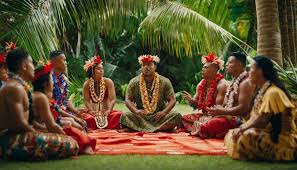Kava, derived from the root of the Piper methysticum plant, holds a significant position in the cultural and social traditions of Pacific Island communities. This powerful plant, a native to the western Pacific, has been utilised for centuries in a variety of rituals, ceremonies, and social gatherings. In this article, we explore the multifaceted role of kava in Pacific Island culture.
Historical Significance of Kava
The use of kava can be traced back over 3000 years across the Pacific Islands. Initially, it was primarily utilised by high-ranking chiefs and priests for its psychoactive properties during sacred ceremonies. Over time, the consumption of kava spread and became a staple in community gatherings and occasions of social importance.
The Cultural Rituals Involving Kava
In many cultures across Fiji, Tonga, Hawaii, and Vanuatu, kava plays a central role in rituals of passage, such as weddings, funerals, and chiefly installations. It is often consumed in a highly structured ceremony where participants sit in a circle while a designated individual mixes the kava by hand or with specific instruments, emphasising the communal aspect of the drink.
Respect for tradition dictates particular protocols during kava ceremonies, such as the order of serving, which reflects the social hierarchy within the community. The elaborate preparation, presentation, and consumption of kava are deeply rooted in the values of respect, loyalty, and camaraderie.
Kava’s Social Implications
Aside from ceremonial purposes, kava serves as an integral facet of everyday social life for many Pacific Islander communities. It functions as a means of conflict resolution, a platform for storytelling, a bonding experience among family and friends, and even as a medium for political discourse.
The communal ‘kava bowl’ symbolises unity and peace, whereby discussions over a communal kava session are thought to foster harmony and to mitigate hostility. The relaxed atmosphere that kava induces is credited with facilitating open communication and understanding among its participants.
Health and Wellness Connections
Traditionally, kava is also attributed with medicinal properties. It is believed to alleviate symptoms of anxiety, stress, and insomnia due to its calming effects. This aspect of kava contributes to its ceremonial value, as participants feel mentally and physically relaxed after consuming it.
Contemporary research into kava has affirmed some of these traditional beliefs, recognising the potential therapeutic benefits of kava, though further studies are often encouraged to understand its full impact on health.
Modern Integration and Challenges
Despite its ingrained presence in Pacific Island culture, the traditional kava culture has faced challenges with modern integration. Urban migration, increasing globalisation, and foreign influences have introduced new dynamics to the traditional kava practices.
In response to these challenges, Pacific communities, both within the islands and in the diaspora, strive to retain the cultural identity and heritage associated with kava. Efforts are made to educate younger generations and to maintain kava-related traditions even in new and evolving sociocultural contexts.
Kava’s Presence in Australia
The Pacific Islander diaspora in Australia has brought kava across the seas, integrating this traditional drink into Australian multicultural society. Today, Australians looking to buy kava Australia can experience the cultural roots and serene effects of this unique beverage.
Establishments like Root & Pestle Kava provide an authentic source of high-quality kava to Australians, ensuring that the cultural significance and traditional preparation methods are preserved and respected. These purveyors of kava recognise the importance of cultural heritage and work to foster a deeper understanding of Pacific Island customs among new kava enthusiasts.
Convenient Forms of Kava
Today, innovation has also made it easier for individuals to enjoy the benefits of kava. The creation of instant kava drink preparations ensures that the tradition can continue in a form that is accessible and convenient for modern lifestyles, without necessitating the traditional and time-consuming preparation process.
Instant kava products retain the essence and benefits of the traditional form yet cater to those seeking a quicker, more accessible means of enjoying kava’s relaxing properties. This modern adaptation ensures that the ritual and community spirit of kava can persevere even as lifestyles evolve.
The Global Spread of Kava Culture
Internationally, kava bars have surfaced in major cities, mirroring the traditional ‘nakamal’ or kava huts found in the Pacific. These spaces serve as cultural hubs where the age-old communal practices are recreated, allowing people from all walks of life to partake in this shared experience.
As kava gains popularity outside the Pacific Islands, it introduces global communities to the pacific cultural landscape, bridging cultural gaps and fostering an appreciation for traditions that have defined the lives of island peoples for millennia.
Safeguarding the Future of Kava Culture
The preservation of kava in Pacific Islander culture is instrumental to safeguarding a unique cultural identity. While embracing modernisation and coping with globalisation, Pacific Island communities, alongside vendors and cultural ambassadors, work tirelessly to ensure that the spirit and social significance of kava remains respectfully acknowledged and continues to be celebrated worldwide.
In conclusion, kava is far more than a mere beverage; it is a potent symbol of Pacific Island identity, cultural resilience, and communal unity. As the world becomes increasingly interconnected, it is essential that such rich traditions are preserved and recognised for their vital role in the cultural tapestry of humanity.
